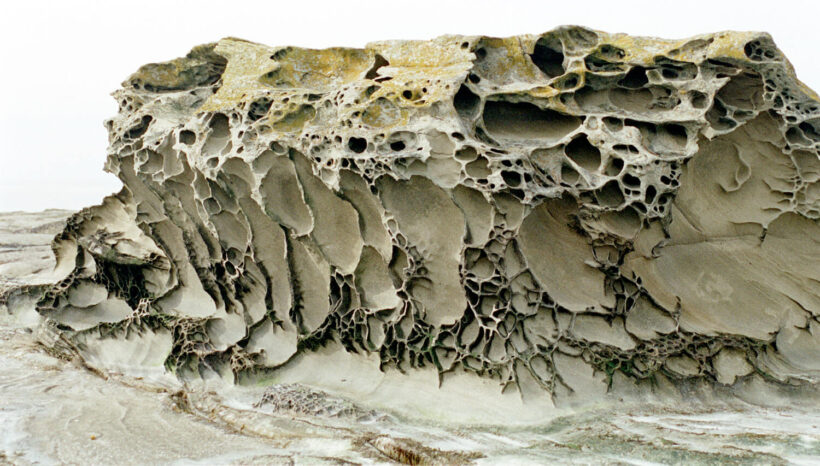Weathering – Chemical + Physical + Biological
Weathering
- The process of wearing away of earth’s surface is commonly known as denudation & is generally carried out in four phases Weathering, Erosion, Transportation & Deposition
- Warm wet climate promotes rapid chemical weathering while dry climate provide good conditions for physical weathering
Chemical Weathering
- Extremely slow & gradual decomposition of rocks due to exposer to air & water
- For example, Granite when exposed to weather is found to be rough surfaced because it is mainly made up of Quartz, Feldspar & Mica; Feldspar is more quickly weathered than Quartz hence is worn away, eventually leaving loosened quartz crystals.
- Regolith > Weathered material from the rock or mineral remains of decomposed rocks.

- When a soil cover on the rock exists, chemical weathering of the rock enhances because the soil absorbs rain water & keeps the underlying rock in contact with this moisture.
- Rain water absorbs organic acids from the soil & thus become a stronger weathering agent than pure water acting on a bare rock.
Types of Chemical Weathering
Solution
- Many minerals are dissolved by water especially with rain water which contains enough carbon dioxide to make it a weak acid.
- For ex. in case of limestone, rain water dissolves calcium carbonate, of which rock is chiefly formed & hence joints & cracks in rock are quickly widened, worming it out easily
- Rocks are more resistant if they have fewer joints or cracks to harbour moisture
- All rocks are subjected to solution upto some extent though the process may be much slower depending not only on mineral composition of the rock but also on its structure, density & climatic conditions it faces.
Oxidation
- Weathering by reaction of oxygen in presence of air & water with minerals present in the rock
- For example most rocks contain certain amount of iron, which when comes in contact with air is changed in iron oxide & finally into rust, which crumbles easily, loosening the overall structure of the rock
Decomposition by Organic Acids
- Within the soil which covers most rocks are bacteria which thrive on decaying plant or animal material
- These bacteria produce acids when dissolved in water, help to speed up weathering of underlying rocks
In some cases, microorganisms and plants like mosses or lichens can live on bare rock damp surface, absorbing chemical elements from the rocks as food & producing organic acids. Hence, they become the agent of both Chemical & Mechanical weathering.
Also read: Atmosphere – Weather and Climate
Physical Weathering
- Also known as Mechanical Weathering
- Disintegration by Mechanical Process
- Types of physical weathering > by insolation, by Frost
By Insolation
Block Disintegration
- Mainly in dry desert areas, hot at day and cold by night
- Leads to expansion & contraction of rock setting up stresses in the rock
- Finally leading to its disintegration
Granular Disintegration
- Different minerals in rock leads to different rate of expansion & contraction of rock
- Leads to Fragmentation of rock for ex. Granite
Exfoliation
- Stresses are naturally greatest near the surface & where there are sharp angles in the rock
- Rectangular blocks are thus gradually rounded by splitting away of sharp corners
- Finally, it leads to peeling off of rock’s outer layer
- Exfoliation also takes place by repeated wetting & drying of rocks surface as during wetting its outer layer absorbs moisture & expand; when they dry this moisture evaporates & they quickly shrinks, finally leading to peeling of outer layer of the rock
By Frost
- Mainly at high altitudes & cold climates where during day cracks & joints inside rock fill with water & during night they get frozen
- This leads to increase in volume of water in rock approx. by 9%
Biological Weathering
- By Men, Animals, Insects & Vegetation
- vegetation grows into crevices of rock cracks or in courtyards or building walls
For more updates, explore the Geography . Feel free to share your thoughts and comments.
If you’re passionate about building a successful blogging website, check out this helpful guide at Coding Tag – How to Start a Successful Blog. It offers practical steps and expert tips to kickstart your blogging journey!










1 comment
thankyou very much to share the knowledge.